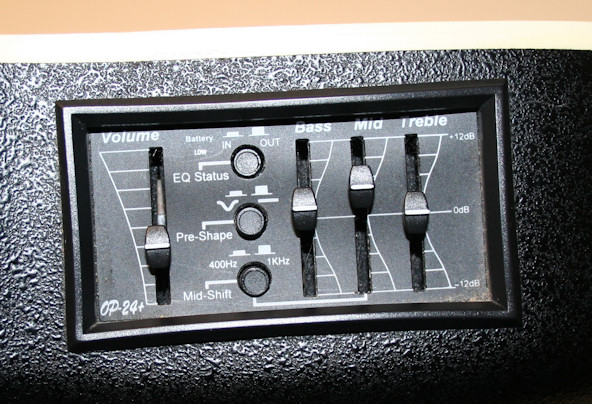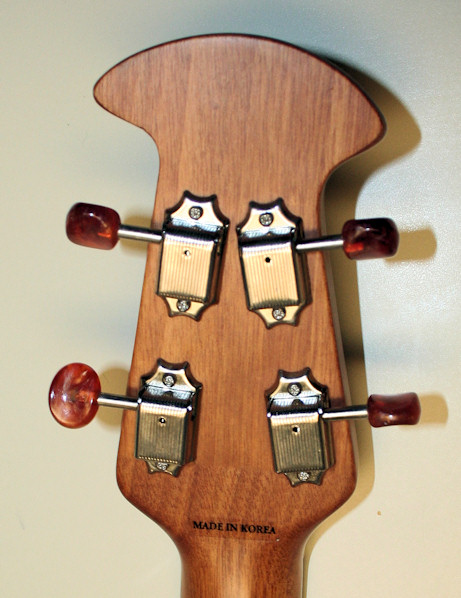





Applause
The Ovation Guitar site has nothing about their Applause line, not the guitars, not the ukuleles. It's almost like Ovation - guitar maker since 1966 - doesn't want to acknowledge them. In fact, the entire Applause line, guitars and all, vanishes from Ovation's promotional horizon like a flatulent relative at a wedding party.
The best I could find about them online was this PDF sales brochure from 2004, hosted on a third party site. All that says about the Korean-made ukes is, "Applause acoustic and acoustic-electric ukes have found their way from World Champion Surfing events to reality television shows. These are no “dime-store” ukes, they’re the real deal." Endorsements like these, I fear, will hardly garner the support of the uke world or even public at large. "Reality" TV isn't exactly aimed at the highest common denominator...
That's a sad comment on Ovation's affection for their little stepchild ukulele, but fortunately not a reflection on the uke itself. The Applause is a fine instrument, although I think it suffers from the schizophrenia of not knowing if it's a small guitar or a big uke.
And big it is, weight-wise anyway. My UA148 tenor tops the scales at 2.4 lbs (just over 1 kg). It's also got a wider body (lower bout) than any other uke I own. You can read some comparison weights in this thread at Fleamarket Music)
Like other Ovation products, it uses the trademark rounded, lyrachord back (it's also written lyracord, which is, apparently, fibreglass, not really plastic). This pushes the sound forward, but offers other challenges, not least trying to hold against your body, or balancing it on a thigh when sitting. But it's somewhat easier to hold in your lap than a Fluke.
The top is laminated spruce. Soprano Applause ukes get solid spruce, so that's a little disappointing in the more expensive tenor (although online comments suggest there is a solid mahogany version available and perhaps other woods - but information is difficult to find).
There are also decorative wooden leaves (exotic wood "epaulets" in Ovation speak) glued around the unusual sound holes (placed to the upper end of the body, on both sides of the neck). Nice as they are to look at, I suspect these epaulets dampen the sound. These are not inlaid flush as they appear to be on recent Ovation guitars, and stand up above the sound board, slightly.
The design has a cutaway to allow greater access to the higher frets (it has 18).
The headstock is attractive, albeit a bit tall, although this design might make it easier to hang on a wall peg. The tuners are inexpensive but sealed, with attractive plastic (mock amber) heads. Rosewood fretboard and mahogany neck, which has a satin finish. Frets were nicely dressed and smooth.
Overall, the sound is much more muted than any other uke I have, with a mellow projection, lots of mid range, and low sustain. It sounds more (dare I say it) like a small guitar than the others. That's not bad, just different. Part of the joy of owning ukes is collecting different sounds and tones. The Applause has its place in a collection for that reason alone.
It's somewhat fuller and fatter than the Fluke sound, too, but that may also be because mine is in low-G tuning while my Flukes are high-G, and a difference in strings.
The neck is a bit thicker than any other uke I've owned, but it's not an impediment to playing. The fretboard edge has a single marker for the seventh fret. I would have preferred a full set because I use these markers frequently when playing. Ah, well, a silver permanent marker will add a few dots.
While the rounded back makes the Applause more difficult to hold, a bit like the Fluke, fortunately it has strap buttons, although unlike most manufacturers, Ovation chose not to use the strap button for the cable jack, and added that a little lower on the body.
The built-in pre-amp is a nice package: it has a volume control, built-in equalizer with slider controls for bass, mid and treble tones, a pre-shape and mid shift buttons. My Applause was a trade, so it didn't come with a manual: I'll have to experiment to figure out what these do. Once plugged in, the Applause loses most of its woody acoustic sound and instead sounds much more like am amplified nylon-string guitar. It has more body in its amplified sound than the Eleuke, however. Ovations electronics get good reviews everywhere. And it is in the amplified sound that the Applause really shines.
The pickup is Ovation's own slimline. The soprano uses a passive pickup, not the active of the tenor. I personally like passive pickups because I think the amp should - can can - do the work of shaping the sound and it saves the horror of having a battery die during a performance. But one can't argue about the good quality of the electronics package provided.
Changing the battery is a test of skill. You need the dexterity of a neurosurgeon combined with the patience of the Dali Lama waiting for the Chinese to get civilized about Tibet and the physical agility of a Cirque du Soleil performer.
First you need to open the back port and carefully remove the cover - held in by four obstinate, stiff springy clips. This requires fishing around inside the back with a finger or two while the cover remains stubbornly attached, trying to locate each clip so the cover can be moved and the clip freed until the port comes off. Then you have to sick a hand inside to hold the battery case (attached to the inside back), because it will fall against the soundboard if you don't. Then loosen the battery screw, remove the 9V battery case, slide the cover off, exchange batteries, and replace the cover. That's the easy part.
Replacing the battery pack inside the uke means stuffing your hand into the back through that port, trying to hold the battery case inside against the back (foam side towards the back) with a couple of fingers, without tangling up in all the wires, and feeling for the small screw slot in the case through a screwdriver precariously balanced against the screw head on the outside - all done blind. The screw fits into the case slot exactly, requiring the precision of a Mars lander finding its destination, with nanometer tolerance for positioning.
Expect to attempt this mating of screw head and slot numerous times. The Space Shuttle docks more easily than these two.
Put aside at least 30 minutes to change the battery, and I recommend learning some Latin vulgarities so you won't as easily offend anyone around you when you start cursing (about three minutes into the procedure).
The battery placement is the most serious drawback to the Applause, and not one to shrug off lightly if you expect to use the electronics at all. Since there doesn't seem to be an off switch for the electronics, the battery will be draining from the moment it's replaced. Be prepared to change it with annoying frequency, especially if you perform live. Who designed this insanity? Is the science of ergonomic design dead?
The Applause is an oddity. It could be a great performance uke with its excellent electronics and pickup. It looks nice, and it's well made and carries a prestigious name. But the battery placement is discouraging. The unamplified sound is acceptable, if not stellar, and would be greatly improved with a solid top. The action and intonation are very good.
This ukulele deserves more attention from its parent company and some place to shine on the company's website. It needs a redesign for its battery placement and perhaps a few ounces trimmed from its hefty bulk. And if Ovation wants to attract serious uke players, switch the laminate to a solid top. That would make it a much more serious contender in a very competitive market.
I am not disappointed with my Applause, merely bemused by its design. It's nice to play and in the end, that's what counts. Mine came with a padded gig bag made by Hohner, with a single shoulder strap and a zippered outside pouch. Mine was also in low-G tuning and I've left it there until I've had some experience with it.
Update, Feb. 09: Comments from Applause owners on various ukulele forums suggest that new models are made in China, while the previous models were made in Korea. There has been some dissatisfaction expressed over the newer models by some posters, although I have not had the opportunity to examine them myself and compare.
I gave this uke to a friend who used to play guitar and admired it. He has since been spending countless hours practicing and enjoying it.
Would I purchase another Applause? Not likely
unless the battery-replacement design changes.
Would I recommend them to others? Perhaps, but with caveats
about the weight, laminated top and the owner-hostile method required to
change the battery.
Rating (0-5): ***1/2 for the instrument alone, ** when you factor in
the battery changing process.
Status: Given away.
